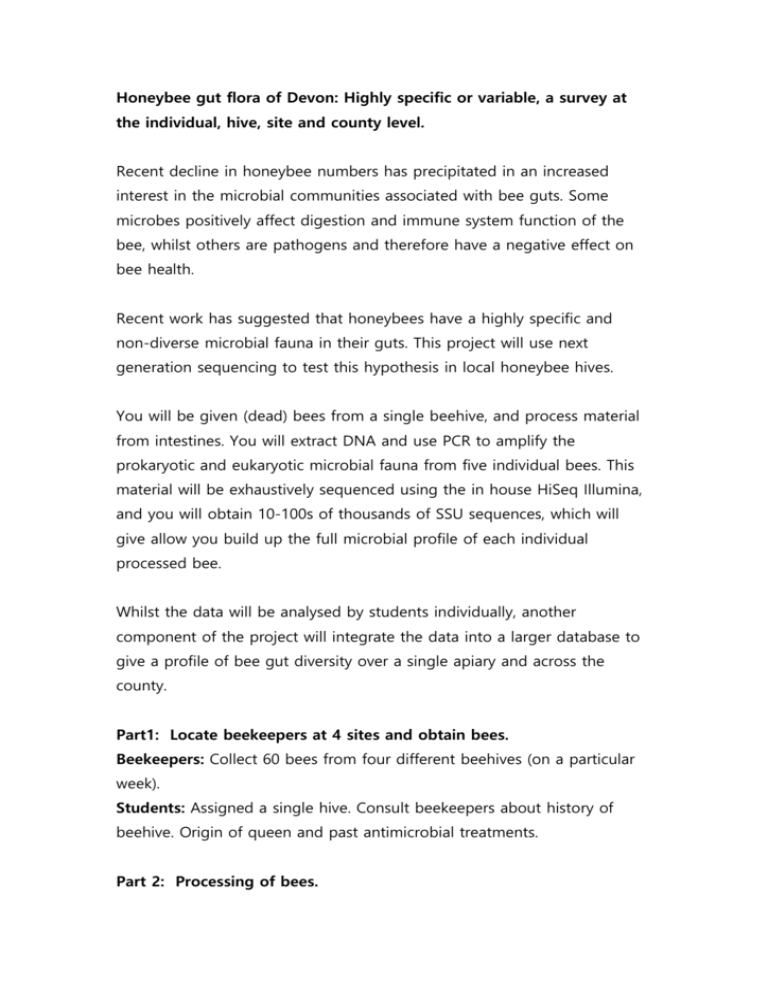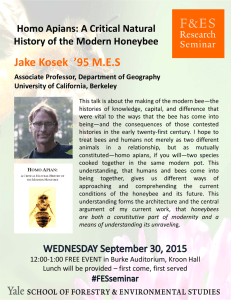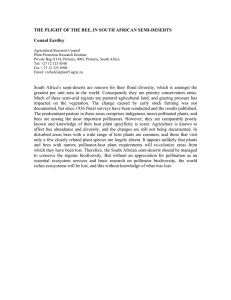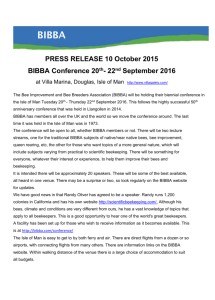Studentsheet - University of Exeter Blogs
advertisement

Honeybee gut flora of Devon: Highly specific or variable, a survey at the individual, hive, site and county level. Recent decline in honeybee numbers has precipitated in an increased interest in the microbial communities associated with bee guts. Some microbes positively affect digestion and immune system function of the bee, whilst others are pathogens and therefore have a negative effect on bee health. Recent work has suggested that honeybees have a highly specific and non-diverse microbial fauna in their guts. This project will use next generation sequencing to test this hypothesis in local honeybee hives. You will be given (dead) bees from a single beehive, and process material from intestines. You will extract DNA and use PCR to amplify the prokaryotic and eukaryotic microbial fauna from five individual bees. This material will be exhaustively sequenced using the in house HiSeq Illumina, and you will obtain 10-100s of thousands of SSU sequences, which will give allow you build up the full microbial profile of each individual processed bee. Whilst the data will be analysed by students individually, another component of the project will integrate the data into a larger database to give a profile of bee gut diversity over a single apiary and across the county. Part1: Locate beekeepers at 4 sites and obtain bees. Beekeepers: Collect 60 bees from four different beehives (on a particular week). Students: Assigned a single hive. Consult beekeepers about history of beehive. Origin of queen and past antimicrobial treatments. Part 2: Processing of bees. Students: Remove the guts from frozen bees, retain the thirty bestdissected samples and transfer to individual eppendorfs for later DNA extraction. Materials required: Petri dishes. Scalpel, forceps, ethanol, flame, bench space, eppendorfs, freezer space. Part 3: Molecular Biology. Students: Extract DNA from bee guts. Extract DNA from ten bees per hive. Grind in a 1.5-ml Eppendorf tube in DNA lysis buffer (consisting of 20 mM Tris–Cl, 2 mM sodium EDTA and 1.2% Triton X-100). Digest with 20 mg/ml lysozyme and incubated for 30 min at 37°C, followed by Phenol/chloroform extraction. PCRs will be carried out on five best DNA samples. 3 PCRs per sample for each primer set. Materials required: 10 primer sets per students, 2 x tagged Prokaryote primers SSU-V9 region (Degnan and Ocham 2012) eukaryote SSU-V6 primers (Amaral-Zettler 2009). Phusion taq, Filter tips, Phenol, Micro pestles. Part 4: Sequencing Students: PCR samples standardised for quantity and pooled and submitted to Konrad for sequencing. Konrad to carry out sequencing and basic analysis including assembly of sequences removal of low quality reads and bioinformatic separation of samples according to tags and remove primers. Part 5: Bioinformatics Students: Prepare pie charts of Genus/Family of eukaryotes and prokaryotes. Use Unifrac to cluster data. Expected data out: Students: Eukaryotic and prokaryotic diversity charts from 5 bees from a single hive. Overall: Microbial profiles of 50-75 honeybees across three or four sites in Devon. Should conservatively get 50000 reads for both Euks/Proks per bee. Reference for methodology: ISME J. 2012 Jan; 6(1): 183-94. doi: 10.1038/ismej.2011.74. Epub 2011 Jun 16. Illumina-based analysis of microbial community diversity. Degnan PH, Ochman H.











